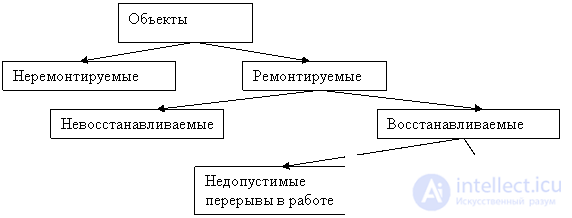Failures can be classified according to various criteria.
1. By the nature of the elimination, one can distinguish between final (stable) and intermittent (now arising, now disappearing) failures. Intermittent failures are the result of reversible random changes in operating modes and parameters of the object. When the mode of operation returns to permissible limits, the object itself, usually without human intervention, returns to a healthy state. For example, a completely serviceable trigger may stop responding to a control signal due to an accidental abrupt decrease in the supply voltage. When the supply voltage again becomes equal to the nominal value, the trigger will continue to operate properly (of course, if a final failure did not occur as a result of ***).
It is advisable to distinguish between two indicators of reliability: for final failures and for intermittent failures.
2. In connection with other failures, one can distinguish between primary failures, i.e. for any reason other than the action of another failure. For example, due to the breakdown of a capacitor, resistance can burn. When calculating reliability indicators, only primary failures are usually taken into account.
Failures are random events that may be independent or dependent. Failures are dependent if the appearance of one of them changes the probability of a second failure. For independent failures, the probability of occurrence of one of them does not depend on whether other failures occurred or not. Thus, the difference between secondary and dependent failures is that after the appearance of a failure of (primary) secondary failure of another element occurs inevitably, and for a dependent failure only the probability of its occurrence changes.
3. For ease of detection, failures can be obvious (explicit) or hidden (implicit).
4. For each specific type of object, failures can be distinguished by external manifestations. For example, various failures of capacitors can be divided into two groups: type of open circuit and type of circuit.
5. By the nature of occurrence, it is possible to distinguish sudden failures, consisting in a sharp almost instantaneous change in the characteristics of objects, and gradual failures occurring at the expense of slow, gradual deterioration in the quality of objects. etc.), because of what these failures are called gross. For sudden failures, there are no visible signs of their approach, i.e. Before failure, it is usually not possible to detect quantitative changes in the characteristics of the object.
Gradual failures (parametric, smooth) are associated with the wear of parts, the aging of materials and the misalignment of devices. Object parameters can reach critical values at which its state is considered unsatisfactory, i.e. failure occurs.
The sudden failure of the object is also a consequence of the accumulation of irreversible changes in materials. In other words, the occurrence of a sudden failure is also a consequence of the random process of changing some parameter of an object, usually associated with its mechanical damage.
Thus, the emergence of any failure is preceded by the accumulation of certain changes within the object.
For objects of different purposes and devices, various indicators of reliability are used. There are four groups of objects that differ in indicators and methods of assessing reliability:
1) non-repairable objects used before the first failure;
2) repaired objects, the restoration of which in the process of application is impossible (non-repairable objects);
3) repaired objects restored in the process of use for which breaks in work are unacceptable;
4) Repairable restored in the process of applying the object for which short-term interruptions in the work are permissible.
The classification of objects by indicators and methods for assessing reliability is shown in Figure 1.1.
Fig.1.1 Groups of objects that differ in reliability indicators.9.



Comments
To leave a comment
Theory of Reliability
Terms: Theory of Reliability